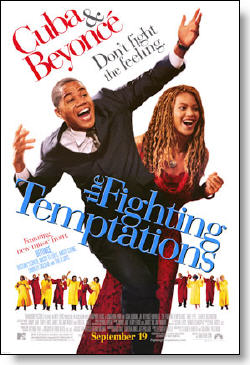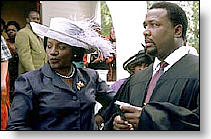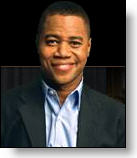Interview with the creators of “The Fighting Temptations” (2003)
by Chris Monroe
Staff Writer

See our REVIEW of “The Fighting Temptations”
Sitting down with the creators of the film “The Fighting Temptations” in New York City prior to the release of the film gave me a much better idea as to the thoughts and designs—even risks—involved in producing this musical filled with Gospel music and spiritual themes. Among the creators I interviewed were:
- screenwriters Elizabeth Hunter and Saladin K. Patterson
- Producer Loretha Jones
- Director Jonathan Lynn
- actors Beyoncé Knowles, Mike Epps, Latanya Richardson, and Academy Award winning Cuba Gooding Jr.
- singer/actor: T-Bone
Screenwriters—Since music is such an integral part of this film, I asked the screenwriters if the story or the music came first, to which they clearly explained it was the story. Elizabeth Hunter wrote it during a time when she felt there was a lot of “black on black” violence (i.e., the murder of rap star Tupac Shakur). Her feeling was that the very thing that was keeping the black community together was the same thing that was keeping them apart, which was music. Because of this she wanted to help bring black people together, particularly different generations, and unite them with a common goal.
An influential factor to creating this story was Hunter’s background with African American literature. During her studies she found a reoccurring theme of black characters that had been estranged reemerging back into community. For this story, it was very important for her to implement the concept of returning to community and embracing basic values. These “basic values” could be interpreted as: going to church, doing the right thing, repenting and remembering where you came from. Also foundational to her script are well-known Gospel songs, such as “Swing Low, Sweet Chariot,” that she thought helped capture the themes she envisioned.
Noticing such strong biblical traits, I asked the screenwriters if they were thinking of the story of the Prodigal Son as they wrote this. Even before I could finish the question, Patterson chuckled, and Hunter chimed in with an emphatic, “Absolutely.” Patterson stated that the idea of the Prodigal Son is at the heart of many stories, and that it is definitely at the heart of this one.
Producer Loretha Jones said that it was a “miracle that a Gospel Musical Comedy was green lit.” She acknowledged that there currently aren’t a lot of films being made about Gospel music, so they were really going against the flow to produce a film with this subject matter. Film executives usually plan projects based on the success of other films, but for “The Fighting Temptations”, there wasn’t really a predecessor. Fortunately, the Development Executive at MTV, Susan Lewis, did not shy away from this risk and was a key player in initiating the project.

I asked Jones if everyone involved with the project had some kind of church background, and, ironically, most everybody did except the director, Jonathan Lynn. He was familiar with different aspects of church, as he told us, but it seems he didn’t really have roots there like others involved.
However, director Jonathan Lynn is no stranger to musicals, having appeared in the original London production of “Fiddler on the Roof” directed by Jerome Robbins. This must have helped him a great deal since he said his biggest challenges were shooting scenes involving 20 to 30 people and having a film that entailed one hour of music. Furthermore, he considers the music here as part of the storytelling and a way to learn about the characters, and not just a break from the rest of the story.
An aspect Lynn was not familiar with was the current music industry, namely the hip-hop music scene, and so had a crash course study on it during pre-production. He did say he was familiar with Gospel music from his youth and pointed out that it is really at the root of all early American music such as jazz, blues and other genres.
Even though Lynn did not have a definitive church background, he did seem a bit familiar with the Gospel—at least through music. He was certain to point out, however, that he considers the film a “musical about a Gospel choir” and not a “Gospel musical.” He clarified this because, in his estimation, the “film is not out to convert people.” He further expounded “it’s about a Gospel choir, but it’s also about universal values.”

Actress Latanya Richardson (wife of actor Samuel L. Jackson) seemed the most open about her faith and openly shared about her beliefs. Ironically, the character she plays, Paulina Pritchett, is the main antagonist of the story and extremely Pharisaical. Richardson came across completely different in the interview compared to the dogmatic and legalistic person she plays in the story.
Richardson frankly said that she does not see this film as a “Christian” movie. She said there would have to be stuff added in and other things taken out for it to be that. While shooting the movie, her and other believers on set would help bring accountability to the production. Having grown up in the church and being an avid churchgoer, there were times her and others advised against choices made that were distasteful or inaccurate about church. In this way, they helped keep the story more truthful.

Growing up, hip-hop pop star Beyoncé Knowles declined acting offers she received because acting wasn’t initially an ambition of hers. She admits now that it “just sort of happened.” The reason she is selective is because she wants to focus on the quality of the work. Now she is ambitious to pursue acting and hopes to do more serious, dramatic roles.
Having made her major film appearance acting opposite Mike Meyers in Austin Powers Goldmember, Beyoncé explained she wanted to get away from more glamorous roles and play someone more common who is dealing with real-life issues. During the production she came up with the idea of having her character, Lily, be a single mom, to which the director agreed and implemented into the story. Although she does have some glam in this role with the nightclub singing, she felt the decision to have her character be a single mom would be someone more people could relate with.
Another element that drew Beyoncé to the role was the involvement of music with the production. Beyoncé explained that she grew up with strict parents and attended church regularly, but their church choir was not very good. After her family began attending a new church, Beyoncé experienced the power in Gospel music and joined the choir. She sang with them for 2 years before the Destiny’s Child trio began.
Comedian Mike Epps unsurprisingly brought the most humor to the interview. He openly denoted that this was the first film he has done where he didn’t do any cursing and was now able to invite his family to see one of his films. The style of films he is usually involved with are like his other film How High, but says he was glad to do a feel-good, family movie.
Cuba Gooding Jr. said he identified with his character, Darrin, in the concept of being successful and also in the idea of returning to one’s roots. As a child, Gooding remembers going every Sunday with his grandmother to the Baptist Church. When he has experienced hard times, Gooding finds himself drawing from this foundation to help get him through.
Another way Gooding related to this story was through all of the music. Gooding’s father was a professional musician (composed “Everybody Plays the Fool”) and always had loud music playing in the house. Gooding also began his career as a breakdancer, working with musicians such as Lionel Ritchie back in the early 1980’s.
An interesting side note is that Gooding said that as he grew up his mother would not allow him to see rated “R” films. She told him that she didn’t want them to “get into his spirit.” As a kid he didn’t understand this, but reflects on it now and says he has finally grasped what she meant.
The Fighting Temptations while not perfect, is a good encouragement and is based on ideas that would indeed be good to get in one’s spirit.
See our exclusive interview with singer/actor T-Bone
See our REVIEW of “The Fighting Temptations”
